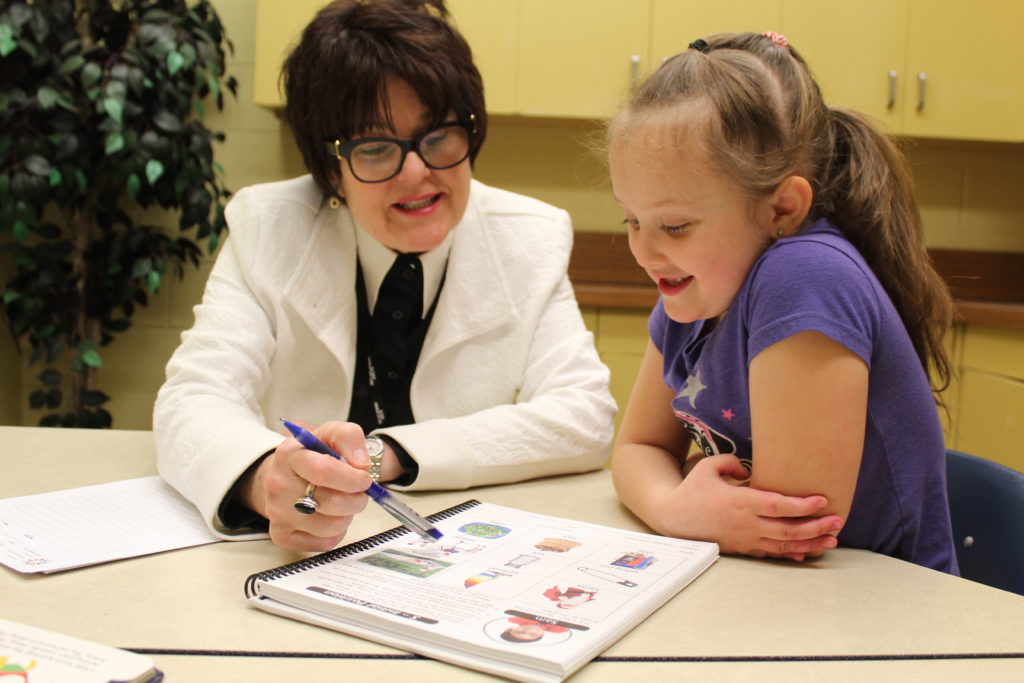
– Photo by Alicia Fox.
Angeline Reimer didn’t think she’d ever be able to talk with her cousin again.
The Lac La Biche area resident is the guardian to Paulette Gagne, a long-term care patient in Smoky Lake. Gagne suffered several strokes about eight years ago, with the final episode leaving her paralyzed on her right side. The strokes caused cognitive dysfunction, leaving Paulette no longer able to read, write, or walk.
However, thanks to speech language therapy treatments, Paulette’s ability to talk has improved markedly.
“[Now] I can communicate with her fairly well,” says Reimer, who visits her cousin at least twice monthly. “There will be a few words that stump her. She will know what she wants, but has a hard time spitting out the words or another word will come out,” she adds.
The strokes have robbed Paulette of being able to comprehend complex concepts and reason.
“She would get frustrated and her therapist would get her to calm down, stop, and have her understand that the words would come to her. Now she takes the time.”
“[It’s] okay to not be okay, and sometimes when you’re okay, others aren’t, and you can help lend a helping hand.”
– Jessica Turowski
Long-term care facilities are just one place where speech language pathologists can be found working in Alberta. They also deliver services in clients’ homes, out of community health units, hospitals, and other community settings, said Dalique van der Nest, the executive director of Allied Health and Volunteer Resources in the Alberta Health Service (AHS) North Zone.
People can access speech language pathology services provided by AHS as well as private agencies on their own or, by referral, through a physician, nurse practitioner, other health professional, or a community partner such as a school.
Speech language pathologists assess and treat infants, children, and adults who have challenges with communication or feeding and swallowing. These challenges includes issues with hearing, speaking, understanding, and using language, including voice utilization and language fluency. These difficulties may be present from birth, develop over time, or result from an illness or trauma, she says.
Speech language pathologists also problem-solve to develop alternate means of communication for non-verbal clients with creative solutions and technology, and, then, coach families, caregivers, and others to learn and use strategies to help clients succeed.
“Speech language pathologists can be pulled into acute care, ICUs [intensive care units], or they can even work in long-term care facilities,” explains van der Nest. “They, in particular, have a huge role to play in pediatrics.”
AHS works closely with communities and community partners to provide coordinated and integrated care.
“We are working with all acute care facilities across the province to ensure people with communication deficits, whether it be apraxia (a neurological disorder characterized by loss of the ability to execute or carry out skilled movements and gestures), people who are deaf, or those with other speech impediments, have the ability to communicate their health needs and participate in their health care more fully to give informed consent,” van der Nest says.
It’s vital that people who have difficulty talking, hearing, or understanding don’t get lost in the care “shuffle,” she insists.
Reimer says she is grateful for the speech language therapy provided to her cousin.
“Before, she would nod her head ‘yes,’ but she couldn’t say it. Now, she can say ‘yes’ and ‘no,’ and you can carry on small conversations with her. She will ask how things are going. You can ask her what she’s been up to, and she’ll tell you things like ‘there’s been a Christmas party.’”
“Her speech is doing wonderfully,” Reimer adds. “[Before therapy,] all she would do is stare at you and smile–nothing would come out of her mouth. She has improved so much.”
— David Olinger
Did you enjoy this article?
Subscribe to the Rural Health Beat to get a positive article about rural health delivered to your inbox each week.
